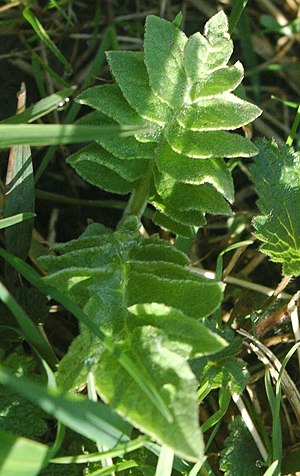Rhaponticum carthamoides
Jump to navigation
Jump to search
This article needs more medical references for verification or relies too heavily on primary sources. (October 2013) |
| Maral root | |
|---|---|

| |
| Scientific classification | |
| Kingdom: | Plantae |
| Clade: | Tracheophytes |
| Clade: | Angiosperms |
| Clade: | Eudicots |
| Clade: | Asterids |
| Order: | Asterales |
| Family: | Asteraceae |
| Genus: | Rhaponticum |
| Species: | R. carthamoides
|
| Binomial name | |
| Rhaponticum carthamoides | |
| Synonyms[1] | |
| |
Rhaponticum carthamoides, also known as Maral root or Rhaponticum, is an herbaceous perennial plant from the family Asteraceae[2] that inhabits the sub-alpine zone (4,500–6,000 ft (1,400–1,800 m) above sea level) as well as alpine meadows. It can be found growing wild in Southern Siberia, Kazakhstan, the Altay region, and Western Sayan Mountains. Maral root is widely cultivated throughout Russia and Eastern Europe. This plant derives its traditional name Maral root (Maralu) from the maral deer who fed on it.
R. carthamoides is high in 20-hydroxyecdysone,[3] one of the most common molting hormones in insects, crabs, and some worms and 20E can disrupt their molting and reproduction.

1985 USSR stamp, depicting Rhaponticum carthamoides
References
- ^ a b "Rhaponticum carthamoides". Germplasm Resources Information Network (GRIN). Agricultural Research Service (ARS), United States Department of Agriculture (USDA).
{{citation}}:|access-date=requires|url=(help) - ^ SysTax - detailed information on Rhaponticum carthamoides (Willd.) Iljin
- ^ Głazowska, Joanna; Kamiński, Marcin M.; Kamiński, Marian (December 2018). "Chromatographic separation, determination and identification of ecdysteroids: Focus on Maral root (Rhaponticum carthamoides, Leuzea carthamoides)". Journal of Separation Science. 41 (23): 4304–4314. doi:10.1002/jssc.201800506. ISSN 1615-9314. PMID 30303602.
Error: "Q820171" is not a valid Wikidata entity ID.
Categories:
- CS1 errors: access-date without URL
- Articles with short description
- Articles needing additional medical references from October 2013
- All articles needing additional references
- Articles requiring reliable medical sources
- Articles with 'species' microformats
- Taxonbars desynced from Wikidata
- Taxonbar pages requiring a Wikidata item
- Taxonbars with invalid from parameters
- Taxonbars without secondary Wikidata taxon IDs
- Cynareae
- Medicinal plants